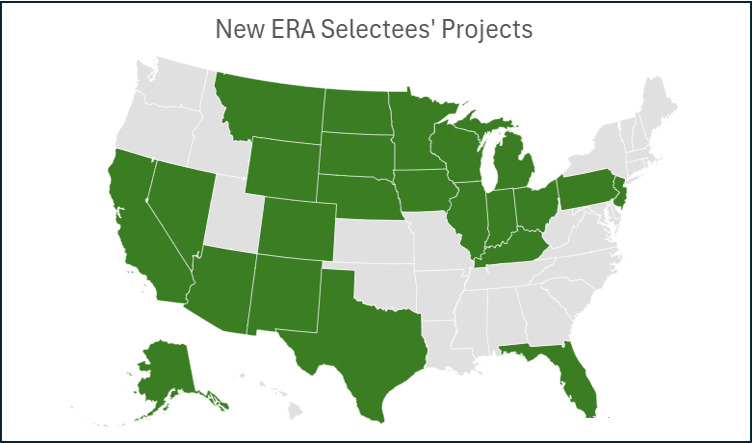Sign up for daily news updates from CleanTechnica on email. Or follow us on Google News!
Projects represent historic investments of $29 billion in clean energy that will benefit 1 in 5 rural Americans

The first wave of 16 rural electric cooperatives (co-ops) selected to receive the USDA’s Empowering Rural America (New ERA) funding plan to leverage their awards to deploy carbon-free energy to help power 5 million homes in rural communities across 23 states, from California to Florida and Texas to Alaska. The majority of new electricity sources that will be funded are solar and wind power. These projects will decrease the cost to generate electricity for rural America, increase the resiliency for communities without sacrificing reliability, and lay the foundation for even more ambitious investments to come:
- USDA estimates these projects will avoid more than 43 million metric tons of greenhouse gas emissions annually (equivalent to the emissions from 10 million gas-powered cars each year).
- USDA estimates New ERA funding will spur the creation of an estimated 4,500 long-term jobs and 16,000 short-term jobs.
- As a result of these projects, renewable capacity supply for rural co-ops will increase by 35 percent from 26 to nearly 35 gigawatts, with wind and solar capacity rising by more than 60 percent from 14 gigawatts to 23 gigawatts.
A few examples of clean energy projects providing real savings to co-op members are Dairyland Power Co-operative, which is expecting rates 42 percent lower over ten years compared with business as usual; and Great River Energy, which expects cost reductions by $30 million annually. More member savings can be found below, compiled from the USDA’s announcement.
“With the help of the New ERA program, rural cooperatives across the country are leading the way in demonstrating how to deploy clean energy to deliver affordable and reliable power for the benefit of their member-owners — and in ways that really work for the communities they serve. The diversity of investments and approaches taken by co-operatives is a testament to the power of the co-op model in fostering innovation tailored to local community needs,” said RMI electricity expert Uday Varadarajan.
The clear winner in terms of technology was utility-scale solar, however an encouraging number of co-ops will also be investing in utility-scale battery storage systems, demand-side resources, and transmission improvements, which can support additional clean energy investments in the future.
RMI (founded as Rocky Mountain Institute) provided resources to applicants in the form of a series of webinars, bootcamps, and a financial modeling tool to support ambitious and efficient project designs by co-ops. We have also published a Community Benefits Catalog to support applicants for federal funding in the creation and execution of community benefit plans (CBPs), to ensure every project supports the long-term growth and financial welfare of local communities.
RMI will be offering co-ops support in the development of their CBPs in the coming months.
This work is made possible with support from Bloomberg Philanthropies and the McKnight Foundation.
Co-ops Offered Awards
| Co-op | States Served | Project Highlights (all emissions reductions are USDA estimates) |
|---|---|---|
| Allegheny Electric Cooperative, Inc. | Pennsylvania, New Jersey |
|
| Arizona G&T Cooperatives | Arizona, California, New Mexico, Nevada |
|
| Basin Electric Power Cooperative | Colorado, Iowa, Minnesota, Montana, Nebraska, New Mexico, North Dakota, South Dakota, Wyoming |
|
| Buckeye Rural Electric Co-op Inc. | Ohio |
|
| CORE Electric Cooperative | Colorado |
|
| Dairyland Power Cooperative | Minnesota, Wisconsin, Iowa, Illinois |
|
| East Kentucky Power Cooperative | Kentucky |
|
| Golden Valley Electric Association | Alaska |
|
| Great River Energy | Minnesota |
|
| Hoosier Energy Rural Electric Cooperative, Inc. | Illinois, Indiana |
|
| Minnkota Power Cooperative | Minnesota, North Dakota |
|
| San Miguel Electric Cooperative Incorporated | Texas |
|
| Seminole Electric Cooperative, Inc. | Florida |
|
| Tri-State Generation and Transmission Association, Inc. | Colorado, Nebraska, New Mexico, Wyoming |
|
| United Power | Colorado |
|
| Wolverine Power Cooperative | Michigan |
|
Background on the New ERA Program and the Inflation Reduction Act
The Inflation Reduction Act (IRA) has been such a boon to co-ops and other nonprofit entities because federal support for electricity infrastructure reinvestment was structurally out of reach for most co-ops until now. Because they are nonprofits, co-ops were previously unable to take advantage of federal incentives — which were offered in the form of tax credits — meant to lower the cost to reinvest in energy systems. Through the IRA’s “direct pay” provision, co-ops can get cash payments from the US Treasury for the full value of federal clean energy tax credits. This allows 30 percent of co-op projects to be covered by the federal government, in addition to any funding awarded through the New ERA program. Similarly, there is an investment tax credit that co-ops can leverage to invest in reliability resources in their systems such as utility-scale batteries. Finally, there are additional incentives for projects that would directly reinvest in the communities that have traditionally relied on fossil fuels for their livelihood, further encouraging reinvestment in the places where their membership needs it most.
This work was made possible thanks in part to the support of the George B. Storer Foundation, which has sponsored the work of organizations helping rural electric cooperatives transition to reliable and affordable clean energy for over a decade.
© 2024 RMI. Published with permission. Courtesy of RMI.
Have a tip for CleanTechnica? Want to advertise? Want to suggest a guest for our CleanTech Talk podcast? Contact us here.
Latest CleanTechnica.TV Videos
CleanTechnica uses affiliate links. See our policy here.
CleanTechnica’s Comment Policy






